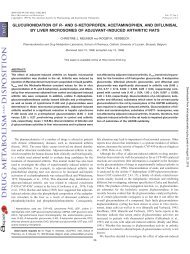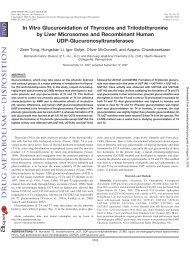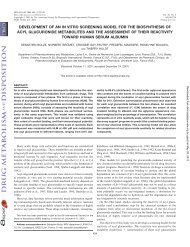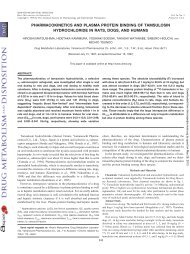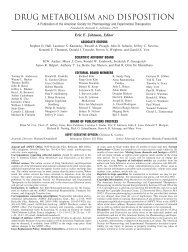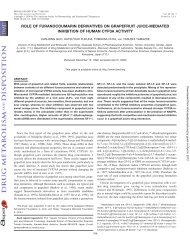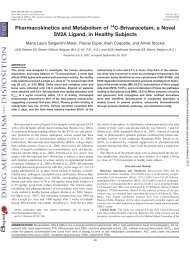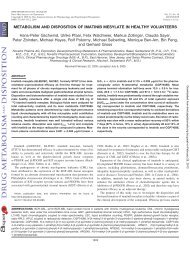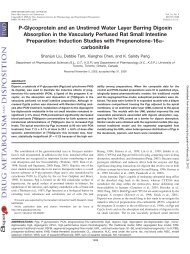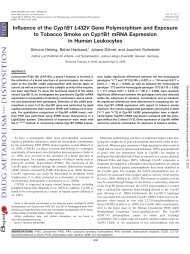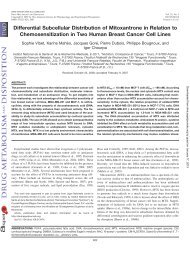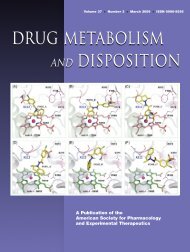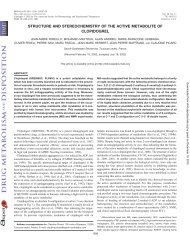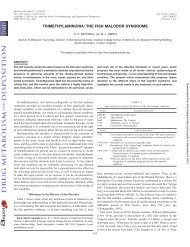metabolism of diallyl disulfide by human liver microsomal ...
metabolism of diallyl disulfide by human liver microsomal ...
metabolism of diallyl disulfide by human liver microsomal ...
You also want an ePaper? Increase the reach of your titles
YUMPU automatically turns print PDFs into web optimized ePapers that Google loves.
DIALLYL DISULFIDE METABOLISM BY HUMAN LIVER MONOOXYGENASES<br />
NADPH, 50 mM Tris-HCl pH 7 in a total volume <strong>of</strong> 500 �l. After 30 min at<br />
37°C, the reaction was stopped <strong>by</strong> adding 320 �l <strong>of</strong> acetonitrile. After 15 min<br />
<strong>of</strong> protein precipitation, the mixture was centrifuged at 10,500g for 10 min and<br />
40 �l <strong>of</strong> the supernatant was analyzed <strong>by</strong> HPLC. The same protocol was<br />
applied with 25 pmol for each cDNA-expressed <strong>human</strong> CYP microsome. In<br />
case <strong>of</strong> cDNA-expressed <strong>human</strong> FMO3 microsomes, 100 �g <strong>of</strong> protein was<br />
added in a total volume <strong>of</strong> 125 �l. Many DADS concentrations were used to<br />
determine the kinetic parameters.<br />
Thermal inactivation <strong>of</strong> microsomes was performed <strong>by</strong> a preincubation <strong>of</strong><br />
microsomes in Tris-HCl buffer for 10 min at 37°C in the absence <strong>of</strong> NADPH,<br />
or in the presence <strong>of</strong> NADPH for control microsomes. Then DADS and<br />
NAPDH were added subsequently to start the incubation for 30 min.<br />
Inhibition <strong>of</strong> DADS Metabolism. Inhibitors were added to the incubation<br />
mixtures before initiation <strong>of</strong> the reaction. Only with the mechanism-based<br />
inhibitors such as diethyldithiocarbamate or aminobenzotriazole, microsomes<br />
were preincubated for 10 min at 37°C before the addition <strong>of</strong> DADS. Nonhydrosoluble<br />
inhibitors were dissolved in 100% ethanol and the following volumes<br />
<strong>of</strong> ethanol were added to the incubation medium (total volume, 500 �l):<br />
0.2 �l for sulfaphenazole and orphenadrine, 0.3 �l for coumarin, 0.4 �l for<br />
diethyldithiocarbamate, 0.5 �l for aminobenzotriazole and quinidine, 0.8 �l<br />
for �-naphth<strong>of</strong>lavone, and 2.5 �l for nifedipine. The <strong>human</strong> samples KS1,<br />
K12, K25, KS28, K33, K40, KS41, and KS63 were used for the inhibitory<br />
experiments.<br />
HPLC Analysis. HPLC analysis was carried out using a Waters (Saint<br />
Quentin-en-Yrelines, France) system equipped with a model 600 pump, a<br />
model 717 auto sampler, a model 996 photodiode array UV detector, and a GL<br />
Sciences Inc. (Tokyo, Japan). Interstil ODS-3 column (4.6 � 150 mm). The<br />
flow rate was 0.6 ml/min and the solvent-isocratic program was 30:70 (v/v,<br />
acetonitrile/water) for 20 min. The spectrum from 190 to 300 nm was used to<br />
detect DADS and its metabolites. The quantification was made at 254 nm. Data<br />
were processed <strong>by</strong> Waters Millenium s<strong>of</strong>tware.<br />
Determination <strong>of</strong> Kinetic Constants. K m and V max were determined with<br />
a range <strong>of</strong> substrate concentrations <strong>of</strong> 0 to 7.5 mM with <strong>human</strong> <strong>liver</strong> microsomes<br />
and FMO cDNA-expressed microsomes, and 0 to 5 mM with CYP<br />
cDNA-expressed microsomes. The values were estimated <strong>by</strong> fitting the<br />
Michaelis-Menten equation using a nonlinear regression program <strong>of</strong> SAS<br />
S<strong>of</strong>tware (Cary, NC). The <strong>human</strong> samples KS1, KS30, K33, and K40 were<br />
used in this experiment. The apparent V max <strong>of</strong> FMO3 cDNA-expressed microsomes<br />
was determined considering that 100 �g <strong>of</strong> protein corresponded to<br />
approximately 100 pmol <strong>of</strong> enzyme. This consideration was based on the<br />
specific activity <strong>of</strong> recent lots <strong>of</strong> FMO3 from Gentest.<br />
Enzyme Assays. Detailed information for these assays are given Table 2.<br />
The coumarin 7-hydroxylase (COH) activity was determined according<br />
to Maurice et al. (1991); dextromethorphan O-demethylase (DOD) according<br />
to Bourrié et al. (1996); 7-ethoxycoumarin deethylase (ECOD) according to<br />
Ullrich and Weber (1972); ethoxyresorufin O-deethylase (EROD) according to<br />
Burke et al. (1985); laurate hydroxylase (LAH) according to Parker and Orton<br />
(1980) with few modifications; mephenytoin hydroxylase (MpH) according to<br />
Meier et al. (1985); methimazole oxidase (MMO) according to Dixit and<br />
Roche (1984); nifedipine oxidase (NfO) according to Guengerich et al. (1986);<br />
p-nitrophenol hydroxylase (PNPH) according to Tassaneeyakul et al. (1993);<br />
and tolbutamide hydroxylase (TDH) according to Bourrié et al. (1996).<br />
Correlation Analysis. To investigate the involvement <strong>of</strong> different CYP<br />
isoenzymes in DADS oxidation, marker activities <strong>of</strong> several isoenzymes<br />
(CYP1A2, CYP2A6, CYP2C9, CYP2C19, CYP2D6, CYP2E1, CYP3A4, and<br />
CYP4A) were measured for at least 24 samples <strong>of</strong> <strong>human</strong> <strong>liver</strong> microsomes.<br />
The enzyme assays were performed as described above. Calculations <strong>of</strong> the<br />
correlation coefficient between the rate <strong>of</strong> transformation <strong>of</strong> DADS and the<br />
marker CYP activities were made with the SAS system (Cary, NC) with the<br />
following equation: r � covariance (x,y) / (variance (x) � variance (y)) 1/2 .<br />
Results<br />
Identification <strong>of</strong> Metabolite. When DADS was incubated with<br />
<strong>human</strong> <strong>liver</strong> microsomes and NADPH, only one peak was detected <strong>by</strong><br />
HPLC (Fig. 2). This peak was identified as DADSO <strong>by</strong> comparing its<br />
retention time in different HPLC gradients and its absorption spectrum<br />
with that <strong>of</strong> synthesized DADSO. No other metabolite was<br />
detected for various incubation times <strong>of</strong> DADS. When either NADPH<br />
or microsomes were omitted, no DADSO was detected.<br />
Kinetics <strong>of</strong> Reaction. The formation <strong>of</strong> DADSO was linear over a<br />
period <strong>of</strong> 45 min. An incubation time <strong>of</strong> 30 min was therefore<br />
routinely used. A concentration <strong>of</strong> 1 mM NADPH was optimal for the<br />
reaction. The kinetic <strong>of</strong> formation <strong>of</strong> DADSO <strong>by</strong> <strong>liver</strong> microsomes<br />
was consistent with the Michaelis-Menten equation. The apparent Km was 0.61 � 0.2 mM and the apparent Vmax was 18.5 � 4.2 nmol/<br />
min/mg protein. Values are means � S.E.M. for four samples.<br />
Contribution <strong>of</strong> FMOs to DADS Oxidation. To evaluate the<br />
respective roles <strong>of</strong> FMOs and CYP in the oxidation <strong>of</strong> DADS, we<br />
initiated incubations <strong>of</strong> DADS in the presence <strong>of</strong> : 1) 1-aminobenzotriazole,<br />
a suicide inhibitor <strong>of</strong> CYPs (De Montellano and Mathews,<br />
1981; Fig. 3 shows the inhibition <strong>of</strong> DADS oxidation <strong>by</strong> this inhibi-<br />
TABLE 2<br />
Incubation conditions for the determination <strong>of</strong> marker enzyme activities in <strong>human</strong> <strong>liver</strong> microsomes<br />
COH DOD ECOD EROD LAH MpH MMO NfO PNPH TDH<br />
Buffer A B C D E B F G H B<br />
NADPH (mM) 1 1 0.05 0.25 1.5 1 0.1 1 1 1<br />
Microsomal proteins<br />
(mg/ml)<br />
0.28 1 0.13 1 0.125 2 0.3 2 1 2<br />
Substrate (mM) 0.1 0.05 1 0.001 0.13 0.2 1 0.2 0.1 2<br />
Total volume (ml) 0.36 0.5 2 0.4 0.5 0.5 1 0.5 0.5 1<br />
Temperature (°C) 37 37 30 30 37 37 37 37 37 37<br />
Incubation time (min) 3 20 4 3 15 30 5 10 20 30<br />
Stop reagent (�l) HCl 1N HCl 1N HCl 1N AcN/TCA<br />
20%, 50/50<br />
Perchloric acid 0.15 M H3PO4 HPLC separation Yes Yes Yes Yes Yes Yes<br />
UV detection (nm) 412 254 340 230<br />
Radiometric detection 14C 14C Fluorometric<br />
detection<br />
Excitation (nm)<br />
380 280 380 522<br />
Emission (nm) 450 312 450 586<br />
A: 50 mM sodium phosphate buffer (pH 7.4)<br />
B: 100 mM potassium phosphate buffer (pH 7.4)<br />
C: 100 mM Tris-HCl buffer (pH 7.7), 1 mM EDTA<br />
D: 100 mM Tris-HCl buffer (pH 7.7), 25 mM MgCl 2<br />
E: 66 mM Tris-HCl buffer (pH 7.4)<br />
F: 0.1 M tricine (pH 8.4), 1 mM EDTA, 0.06 mM 5,5�-dithiobis(2-nitrobenzoate), 6 mM potassium phosphate (pH 8.4), 0.02 mM dithiothreitol<br />
G: 50 mM potassium phosphate buffer (pH 7.4), 3 mM MgCl 2<br />
H: 100 mM sodium phosphate buffer (pH 6.8)<br />
837<br />
Downloaded from<br />
dmd.aspetjournals.org <strong>by</strong> guest on November 24, 2012



